![]()
![]()
![]()
Use LEFT and RIGHT arrow keys to navigate between flashcards;
Use UP and DOWN arrow keys to flip the card;
H to show hint;
A reads text to speech;
50 Cards in this Set
- Front
- Back

What do A, B, C, and D stand for?
|
A = CA B= HA C= SA D= SMA
Aorta is the largest artery in body – composed of 3 sections – root arises from left ventricular outflow tract |
|
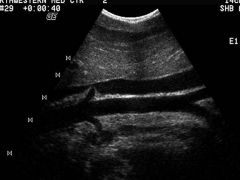
A=
B= What visceral artery arises just proximal to the aortic bifurcation? |
The inferior mesenteric artery arises just proximal (1 cm) to the aortic bifurcation
A= renal arteries B=iliacs |
|
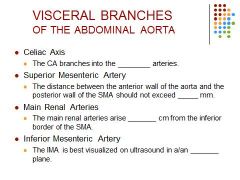
|
CA branches into the splenic, left gastric and common hepatic arteries
The posterior wall of the SMA should not exceed 11mm from the anterior wall of the aorta. The main renal arteries arise 1.0 – 1.5 cm from the inferior border of the SMA The IMA is best visualized in an oblique plane. |
|
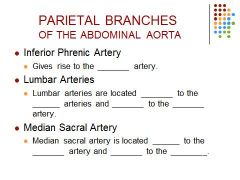
|
The inferior phrenic artery gives rise to the suprarenal artery.
The lumbar arteries are located inferior to the gonadal arteries and superior to the inferior mesenteric artery. Median sacral artery is located inferior to the inferior mesenteric artery and superior to the aortic bifurcation |
|
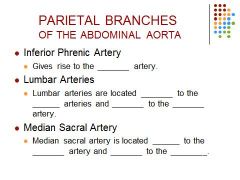
|
The inferior phrenic artery gives rise to the suprarenal artery.
The lumbar arteries are located inferior to the gonadal arteries and superior to the inferior mesenteric artery. Median sacral artery is located inferior to the inferior mesenteric artery and superior to the aortic bifurcation |
|
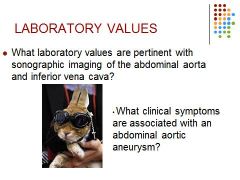
|
Lab values:
none really – HDL or LDL possibly Symptoms: Asymptomatic Pulsatile abdominal mass Abdominal, back or leg pain |
|
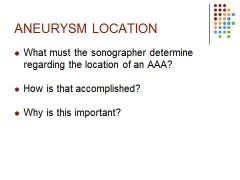
|
1. Whether it is infra or suprarenal in location
2. Distance from the SMA… infrarenal if located greater than 1.5 cm inferior to the inferior border of the origin of the SMA. 3. Increased complications when suprarenal in location because it would affect the kidney. |
|
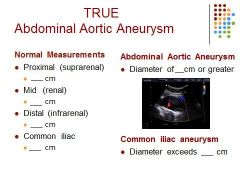
|

|
|
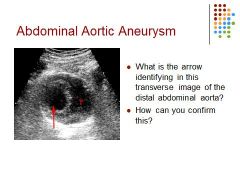
|
The arrow is pointing to the lumen in a distal AAA with adjacent thrombus (T). This can be confirmed using Color or spectral Doppler.
|
|
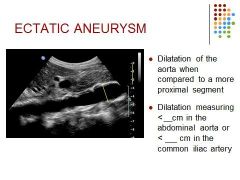
|

|
|
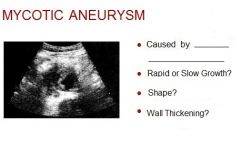
|

Palpable mass midline – bacterial infection are signs; saccular = large and spherical
|
|
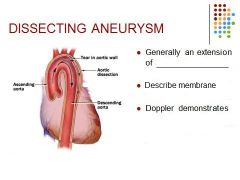
|

40-60 year old males affected most – chest pain – look for flap – thin hyperechoic membrane
|
|
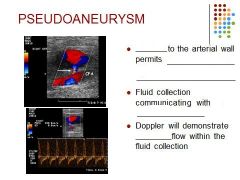
|

Looks like hematoma but is pulsatile
|
|
|
|
Looks like hematoma but is pulsatile
|
|
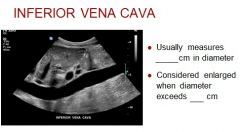
|

|
|
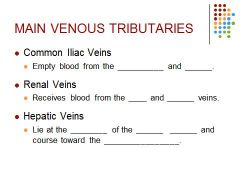
|
Common Iliac Veins: Empty blood from the lower extremities and pelvis
Renal Veins: Receives blood from the suprarenal and left gonadal veins. Hepatic Veins: Lie at the boundaries of the hepatic segments and course toward the IVC. |
|
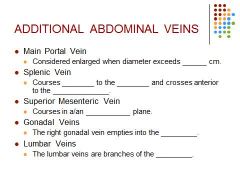
|
Main Portal Vein: Considered enlarged when diameter exceeds 1.3 cm
Splenic Vein: Courses posterior to the pancreas and crosses anterior to the SMA SMV: Courses in a sagittal plane, parallel to the SMA. Gonadal Veins: The right gonadal vein empties into the IVC Lumbar Veins: The lumbar veins are branches of the common iliac veins. |
|
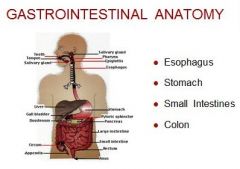
How does the stomach inhibit ultrasound?
How does the stomach aid ultrasound? What are the divisions of the small intestines? What are the divisions of the colon? |
How does the stomach inhibit ultrasound? air inhibits transmission of the sound wave
How does the stomach aid ultrasound? water in the stomach can aid in visualization of the pancreas What are the divisions of the small intestines? Duodenum, jejuneum, ileum What are the divisions of the colon? Cecum, appendix, ascending colon, transverse colon, descending colon, sigmoid, rectum and anal canal |
|
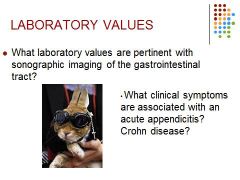
|
Lab values:
Leukocytosis Symptoms: Appy: RLQ pain (McBurney sign), Leukocytosis, Spiking fever Crohn disease (inflammation of bowel wall): Abdominal cramping, diarrhea, fever, blood in stool, decrease in appetite (weight loss). |
|
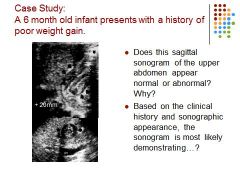
|
Hypertrophied pyloric stenosis demonstrates marked thickening of the circular muscle of the pylorus
Sonographic appearance: Thickness of pyloric wall > 3-4 mm Pyloric diameter > 15 mm Pyloric canal length > 18 mm Dx: Hypertrophied pyloric stenosis |
|
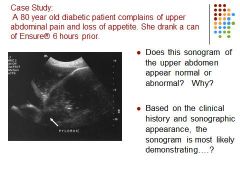
|
Abnormal gastric dilatation: Diabetic patient’s have an increase incidence of gastroparesis. Long standing distention of the stomach with fluid demonstrating swirling motion with decrease or lack of forward peristalsis is suspicious for abnormal gastric dilatation.
|
|
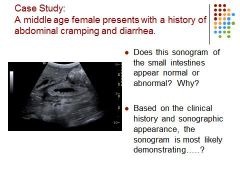
|
Inflammation of the intestines (i.e Crohn disease)
Sonographic appearance: thick loops of bowel, matted loops of bowel, abscess formation, lymphadenopathy. |
|
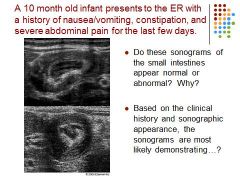
|
Intussusception
Sonographic Appearance: Edematous bowel, Multiple circular rings (donut sign), Hypervascular intestinal wall. |
|
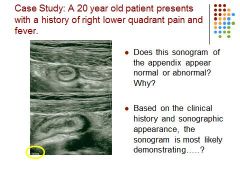
|
Appendicitis – the diameter of this appendix is 9 mm exceeding the normal range of 6 mm.
Non- compressible tubular structure Diameter of appendix exceeds 6 mm Wall thickness exceeds 2 mm |
|
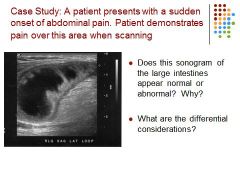
|
Ileus – bowel obstruction
Normal fluid filled loop of bowel Describe to the radiologist your findings… Did this area of bowel demonstrate normal or abnormal peristalsis? |
|
|
The portal veins carry blood from the _____ to the liver.
A) hepatic artery B) intestine C) splenic artery D) peripheral venous system |
B) intestine
|
|
|
The arterial supply to the gallbladder is via the:
A) hepatic artery B) superior mesenteric artery C) cystic artery D) gastroduodenal artery |
C) cystic artery
|
|
|
Portal veins do not drain blood:
A) out of the gastrointestinal tract from the lower end of the esophagus to the upper end of the anal canal B) from the pancreas, gallbladder, and bile ducts C) from the spleen D) from the kidneys |
D) from the kidneys
|
|
|
What vessel passes anterior to the third part of the duodenum and posterior to the neck of the pancreas?
A) the superior mesenteric artery B) the superior mesenteric vein C) the inferior mesenteric vein D) the splenic vein |
B) the superior mesenteric vein
|
|
|
The head of the pancreas, the duodenum, and parts of the stomach are supplied by the:
A) hepatic artery B) gastroduodenal artery C) splenic artery D) superior mesenteric artery |
B) gastroduodenal artery
|
|
|
Which of the following vessels passes anterior to the uncinate process of the pancreas?
A) the hepatic artery B) the portal vein C) the left renal vein D) the superior mesenteric vein |
D) the superior mesenteric vein
|
|
|
The distribution of the superior mesenteric artery is to the:
A) distal half of colon, liver B) proximal half of colon, stomach C) small intestine, proximal half of colon D) large intestine, distal half of colon |
C) small intestine, proximal half of colon
|
|
|
What vein begins at the hilum of the spleen and is joined by the short gastric and left gastroepiploic vein?
A) the pancreatic vein B) the portal vein C) the superior mesenteric vein D) the splenic vein |
D) the splenic vein
|
|
|
Which of these statements is false?
A) The portal vein enters the lesser omentum. B) The portal vein is formed anterior to the pancreas. C) The portal vein drains blood out of the gastrointestinal tract. D) The portal vein has an anastomosis with the esophageal veins, rectal venous plexus, and superficial abdominal veins. |
B) The portal vein is formed anterior to the pancreas.
|
|
|
The normal diameter of the aorta is less than
A) 2 mm B) 5 mm C) 8 cm D) 3 cm |
D) 3 cm
|
|
|
Budd-Chiari syndrome demonstrates thrombosis of the:
A) hepatic veins B) hepatic arteries C) portal veins D) inferior vena cava |
A) hepatic veins
|
|
|
The inferior mesenteric artery distributes blood to the:
A) left transverse colon, descending colon, sigmoid, rectum B) ascending colon, sigmoid, rectum C) descending colon D) ascending colon, rectum |
A) left transverse colon, descending colon, sigmoid, rectum
|
|
|
The right renal artery passes_____ to the inferior vena cava (IVC).
A) anterior B) posterior C) lateral D) medial |
B) posterior
|
|
|
The vessel that arises from the anterior aortic wall and takes a parallel course to the aorta is the:
A) hepatic artery B) renal artery C) superior mesenteric artery D) inferior mesenteric artery |
C) superior mesenteric artery
|
|
|
What vascular structure courses between the aorta and SMA?
A) left renal vein B) celiac trunk C) gastroduodenal artery D) left renal artery |
A) left renal vein
|
|
|
Renal arteries branch from the lateral wall of the aorta:
A) at the level of L4 B) superior to the SMA C) superior to the hepatic arteries D) inferior to the SMA |
D) inferior to the SMA
|
|
|
The IVC courses anteriorly to enter the:
A) right ventricle B) left atrium C) right coronary sinus D) right atrium |
D) right atrium
|
|
|
Which vascular structure arising from the celiac trunk passes anterior to the portal vein to enter the liver at the porta hepatitis?
A) the common bile duct B) the hepatic artery C) the superior mesenteric artery D) the gastroduodenal artery |
B) the hepatic artery
|
|
|
Which of the following structures is medial to the inferior border of the pancreas?
A) the splenic artery B) the hepatic artery C) the superior mesenteric artery D) the splenic vein |
D) the splenic vein
|
|
|
The gastroduodenal artery is a branch of the:
A) right hepatic artery B) left gastric artery C) splenic artery D) superior mesenteric artery |
A) right hepatic artery
|
|
|
The most common cause of abdominal aneurysms is:
A) cystic medial necrosis B) syphilis C) atheroma D) arteriosclerosis |
D) arteriosclerosis
|
|
|
22. In patients with lower trunk and leg edema and a dilated IVC, a(n) _____ should be suspected.
A) rupture B) atrioventricular fistula C) retroperitoneal tumor D) infection |
B) atrioventricular fistula
|
|
|
The most common tumor to fill the IVC is:
A) islet cell carcinoma B) renal cell carcinoma C) venous angioma D) nephroma |
B) renal cell carcinoma
|
|
|
The clinical signs of leg edema, low back pain, pelvic pain, gastrointestinal complaints, and renal and liver problems may represent:
A) abdominal rupture B) superior mesenteric thrombus C) retroperitoneal tumor D) IVC thrombosis |
D) IVC thrombosis
|
|
|
Which statement is false for a patient with renal vein thrombosis?
A) Direct visualization of thrombi in the renal vein and IVC is possible. B) There is loss of normal renal structure. C) Renal size increases in the acute phase. D) Doppler flow increases. |
D) Doppler flow increases.
|

